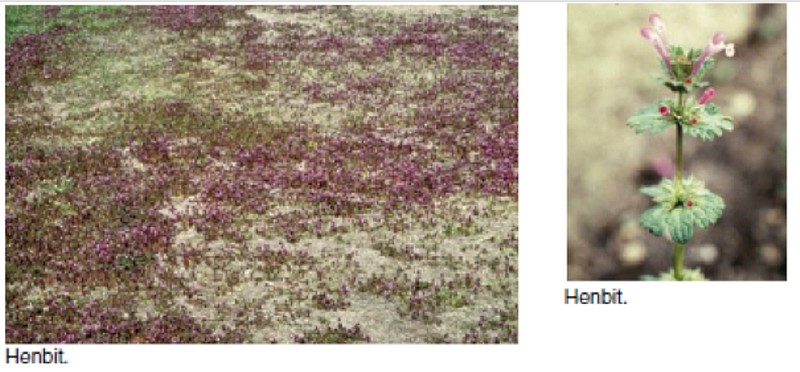Q: What are these annoying little weeds with purple flowers? How can I get rid of them, or better yet, keep them from occurring next year? Are they good for anything?
A: The two early season small "weeds" with purple flowers are henbit and purple deadnettle. Both are winter annuals; they germinate in the fall and into late winter, then come on strong in March. They don't like warm weather, so with just regular mowing they'll quickly fizzle. They often occur together. I noticed them side by side in my lawn. They are easily distinguished by the flower position - henbit is held above the foliage and deadnettle's flowers poke out from under the leaves. They benefit pollinators so where you can tolerate them, let them grow.
Spraying them with a lawn weed killer will hasten their decline, but it's questionable if it's worth the effort in a lawn. Both pull up easily if they are in flowerbeds, but they could be spot sprayed there. To prevent them, in the fall, use a pre-emergent herbicide like Preen in flowerbeds or a crabgrass preventer in the lawn. Most folks don't think about them in the fall though.
Q: I have a very small lawn, less than 1,000 square feet, and would like to control crabgrass. Is there some way to do this other than putting down crabgrass preventer? They only sell it in bags to treat 5,000 square feet.
A: You are right to be concerned about purchasing a granular crabgrass preventer (that should be put down by April 15); these products often have fertilizer included. You would need to keep the product tightly sealed up and use it more than five years. That's the small bag, the larger one treats 15,000 square feet. If moisture gets into the product, not only will it clump and be difficult to spread, the nitrogen in the fertilizer can volatilize and be lost. A good alternative is to apply a lawn weed herbicide that is also labeled for controlling crabgrass. These products are applied as a spray, and a good time to apply would be in early May and again as the label recommends if crabgrass comes back.
Q: I have a 10-year-old weeping willow that suffered winter storm damage. We trimmed off the ones that broke, but now one side is leafing out slower than the other side. At the base of the tree a nasty brown patch has formed. What's going on, and how do we help it recover?
A: Branches that leaf out late or weakly have often suffered vascular damage. Hope for the best (that they recover) but if there is sufficient vascular damage, woody plants may leaf out and then when the first hot and stressful weather hits, that growth kind of fizzles. So it is best to wait until June before pruning this tree to remove any damaged limbs remaining. Avoid any pruning to 'balance' the tree. It needs all the branches/foliage it has to rebuild its vigor. You can do pruning to balance its form early next spring and again in 2021. Since willows are fast growing, it should regain it form relatively easily.
On the brown color at the trunk, that is a stress response. We often see it in drought years. It is generally regarded as bacterial and generally isn't killing the tree - more a symptom (snotty nose with a cold) than the cause (virus). It could, if the trunk was stressed (e.g. leaning) or suffered other damage from a broken limb, indicate vascular damage. Again, hope for the best. To aide the tree, establish a mulch ring around the base about 6 feet in diameter and water it when droughty conditions occur.
Q: When is the annual Master Gardener plant sale?
A: It is May 4 at the Jefferson City Jaycees Fairgrounds. Gates open at 7 a.m. For more information see: extension.missouri.edu/cole/.

